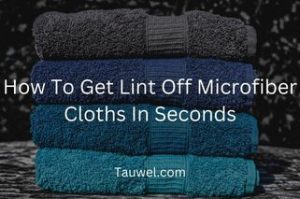This post contains affiliate links. Read the full disclosure here.
This is a very important question considering that the essence of microfibre cloths is to scrub, take off dirt and remove lint. And so, it is very paramount that you know just how to remove lint from your microfiber cloth to get the best out of them when in use.
Below is an outline of simple steps that you can adopt in getting lint off your microfiber cloth. But first, here is a list of the materials you would need.

Contents
Pro Steps To Get Lint Off Microfiber Cloths
Materials
- Brush (preferably soft-bristled)
- Lint removal roller
- Painters tape
- Washing Soap
- water
Procedures
1. Give microfiber cloths a good shake in order for dirt, dust, and debris to fall off. Washing without shaking off would mean that the dirt would be floating inside the washing water where they can easily be reintroduced to the washed microfiber cloths again.
In a Hurry? Don’t go without checking this TRENDING Topic Out - 6 Best Towels For Blackstone Griddle In 2022 out
2. Choose detergents that are microfiber friendly. Detergents with any form of additives are a No-No for washing microfiber cloths. This is because; they could block the fibers and reduce its effectiveness
3. Wash microfiber cloths with soap and warm/semi-hot water. For a better result, you can soak them for a few hours before washing them.
4. After washing, spread on the line outside to dry. Line drying is mostly advised because the microfiber cloths are naturally prone to attracting dirt and lint even when you don’t want them to.
You just might need to start getting used to the fact that the microfiber towels cannot stay idle. They easily pick up this lint even in a dryer.
All the same, when using a dryer, have it set on very low heat or better still, no heat, and ensure you dry them alone or along with other microfiber materials.
5. Most times, even after washing, lint might still be found on the microfiber cloth. When this happens, just brush out lint and other remaining debris using a brush. Brushes used in taking out lint should be very soft so as not to destroy the fibers.
6. Manually picking threads and other forms of lint is very much possible but, can be time-consuming. Instead, gently but continuously stroke with a lint remover to completely remove lint or dirt.
There are lints and dirt deeply ingrained in some towels which you might not see. The good thing is that the lint removal also called the lint roller, takes care of fishing them out.
7. Take your painter’s tape, cut out a generous amount, and make it into a ball. The next step is to use the tape ball to remove lint by patting all over making sure that you touch every corner.
8. You might be lucky to have the lint on your microfiber towel removed from the 1st step. However, you might have to do a combination of all the methods if the lint present is a lot and seems difficult to take out.
Instructions
- Do not wash microfiber cloths together with other materials for that is the quickest way to get lint on them
- If possible, try hand washing your microfiber cloths. This is because; there is always a possibility of them collecting lint from the washing machine.
- Always wash your microfiber cloths after every use. Your microfiber cloths have to be clean to give you a great clean.
- Once again, remember the golden rule: wash microfiber cloths alone and dry them alone too.
Why does my microfiber cloth keep attracting lint?
Relax… your microfiber cloth is doing just what it was invented to do. I personally define microfiber cloths as the nightmare of dirt and debris. They can’t just seem to leave them be, constantly attracting dirt and lint to themselves.
Do you know why? It’s because they have a set of extremely ‘grabby’ fibers that attract and hold on tightly to germs, dirt, and debris.
Take a careful look at that microfiber towel and touch it. What do you feel? Does it feel like the very tiny delicate substances are attempting to grab your hands? If your answer is yes, it means you have got a high-quality microfiber towel there.
What else can the microfiber cloth attract apart from lint?
Microfiber cloths attract negatively charged substances like grease, grime, dirt, hair, threads, and dust. The good thing about the way a microfiber cloth sucks in dust and dirt is that it traps them to itself and retains them.
Unlike other dusting materials that only transfer dust from one place to another. You only have the dirt released when you give the cloth a good wash.
How to preserve your microfiber cloth
It is a given that microfiber cloths can serve you for years while still maintaining its super-efficient cleaning streak. But, you should also know that its longevity is closely tied to how well you take care of it.
Effective care of your microfiber cloth from cleaning to drying and then storing is the only way to guarantee you get great value for your money. Continue reading to find out the right way to preserve your microfiber cloths.
- Like earlier stated, ensure you wash microfiber cloths after each use. Do not keep them dirty for too long. It is easier for grease and grime to be washed out early than when it is allowed to get dry on the material.
- After washing, make sure the microfiber cloths are very dry before folding them to keep. Your microfiber cloths are at risk of having a nasty smell or mold developing on them if you do not allow them to dry up completely.
- Keep clean microfiber cloths separately. Do not place them together with dirty ones or with other kinds of material even if they are clean.
- When not in use, place clean microfiber cloths in an enclosed place or better still a container with a lid. Hanging them outside or on kitchen shelves would see them working without you using them. That’s right, they stay working attracting lint and pulling them in like a magnet! This would make them unfit for use until you wash them again.
- Have several microfiber cloths for different uses. One microfiber towel should not be made to multitask i.e clean every area of the house. That is far from being hygienic. Having several microfiber cloths for different purposes hygienic would prevent them from being overused and wearing out faster.
- Be acquainted with every detail on the product description. The product description tag is where you will find the necessary details on how to care for your microfiber cloths.
A lot of people leave their microfiber towels to be mercilessly ravaged by lint. Extreme measures might need to be taken depending on the amount of lint found on the microfiber towels. You might need to soak in hot water, using a cup full of any type of microfiber revitalizer to redeem your towels.
FAQs
Do microfiber cloths last long?
One of the advantages the microfiber cloth has over other cleaning materials like cotton cloth, for instance, is that it lasts long and not only that, remains effective even as it ages.
All this though, is dependent on the quality of microfiber towels you buy, what you use them for and how well you care for them.
What is the importance of lint-free microfiber cloths?
Naturally, microfiber cloths are meant to remove lint, dirt, debris, bacteria, grease, and so on. They are positively charged materials and attract these negatively charged substances, drag them in and retain them leaving your environment squeaky clean and safe from germ-causing diseases.
However, the microfiber cloths cannot function optimally with lint on them. That is why it is advised that you wash them after each use in order to release the lint on them and get them ready for the next cleaning exercise.
For instance, cleaning with a microfiber cloth full of lint would leave streaks and germs untouched and that would be a wasted effort on your part.
Are there different types of microfiber towels?
There are different kinds of microfiber cloths produced to serve different purposes. These microfiber cloths come in different grades meant to be used at different levels of cleaning.
Before buying, you first of all, have to consider the type of cleaning you want it for. The microfiber towel used in cleaning kitchen counters and surfaces would not be as effective or strong enough to scrub bathrooms or upholsteries.
There are microfiber towels made extremely thick with stronger and longer fibers to cater for very intense cleaning chores.
We also have the towels made for basic cleaning exercises like wiping glasses, cleaning countertops, drying plates, and so on.
This is why you have to factor in your own personal need when getting the towels. A person who needs a microfiber towel for use in a car shop has no business purchasing the regular ones meant to simply dry plates.
How To Get Lint Off Microfiber Cloths – Conclusion
Microfiber cloths are highly important cleaning tools useful in homes, offices, hospitals, restaurants, and public bathrooms, in fact, the list is endless.
They are ingrained with super effective fibers that do a fantastic job in the cleaning of your environment. However, for your microfiber cloth to continue serving you dexterously, you have to make a conscious effort to properly care for them
The Microfiber cloths are super strong yet, very delicate materials that need to be cared for in a special way in order for them to continue giving their best in all your cleaning chores.



